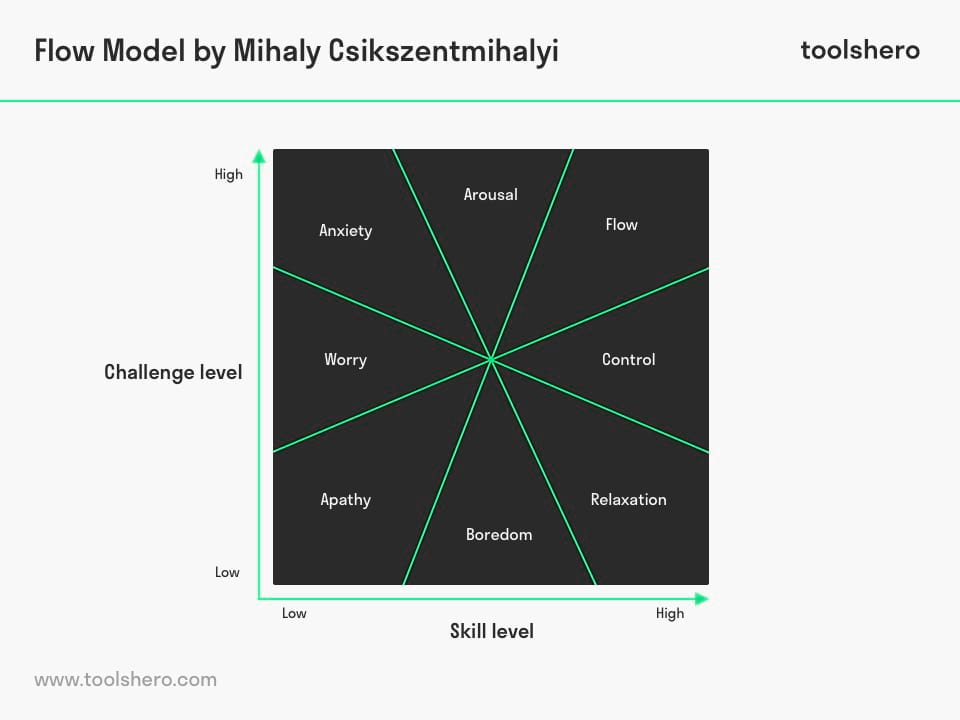Flow Theory by Mihaly Csikszentmihalyi

Flow theory: this article explains the Flow theory by Mihaly Csikszentmihalyi in a practical way. Next to what it is, this article also highlights the conditions within this theory and in practice. After reading you will understand the basics of this positive psychology tool. Enjoy reading!
What is Flow?
“Go with the Flow” has become an established saying, but was originally invented by the American psychologist Mihaly Csikszentmihalyi. He is one of the founders of the so-called “positive psychology”.
There are many celebrities that immerse themselves in “the Flow” such as Richard Branson, Stephen Covey and Nelson Mandela.
Everything they do seems to be easy and controlled. Mihaly Csikszentmihalyi describes that people are happiest when they are in the state of utter concentration and completely absorbed in the activity they are carrying out. This Flow is identical to the feeling of being “in the zone” or “in the groove”.
Flow Theory
The Flow Theory of Mihaly Csikszentmihalyi represents the emotional state someone can be while undertaking a task or activity.

Figure 1 – emotional states within the flow theory (Csikszentmihalyi)
This happens on the basis of the two weighing ratios the challenge level and the skills level that are balanced against each other. From this point he describes eight emotional states of mind someone can be in:
Apathy
Comparable to a state of indifference and a lack of interest.
Boredom
No interest in surroundings, dull, fatigued.
Relaxation
Calm or the absence of excitement.
Worry
By worrying the attention is shifted towards negativity; (imaginary) problems become bigger and solutions do not seem to exist.
Control
By practising, skills become automations, with the risk that the skills level is higher than the challenge to perform a certain task.
Anxiety
May cause someone to freeze and stagnate.
Arousal
By increased stimuli people respond more attentively to their environment.
Flow
Mental state in which people are completely focused on the activity or task, because of which this is carried out successfully.
Conditions within the Flow Theory
Only during a big challenge or high skill the flow can develop itself. In the centre of the Flow theory all frames of mind come together and the challenges and skills are of an average level. Depending on a number of factors, growth towards flow can be effected according to Mihaly Csikszentmihalyi.
The three most important factors in this are:
- Formulating clear objectives in relation to the tasks and the activities.
- A good balance between the challenges of the activities and the understanding of one’s own skills.
- Good interim feedback (feedback loop) and after the tasks and activities have been carried out and (timely) adjustments if necessary.
The Flow theory in practice
The Flow theory can make an excellent contribution on the work floor and it can create improvement and increase effectiveness.
Some examples:
- because of clear objectives work is carried out more effectively;
- because of a heightened state of concentration people are better focused on carrying out their tasks and activities;
- by developing self-confidence skills will increase;
- by understanding the positive effect of feedback it is possible to carry out a timely intervention;
- working well together and synergy create innovation;
- there is an opportunity to develop personal skills and to be stimulated by personal coaching.
It’s Your Turn
What do you think? Do you recognize the practical explanation of the Mihaly Csikszentmihalyi Flow Theory or do you have more additions? What are your success factors for achieving flow?
Share your experience and knowledge in the comments box below.
More information
- Csikszentmihalyi, M. (1997). Finding Flow: The Psychology of Engagement with Everyday Life. Basic Books.
- Csikszentmihalyi, M. (1975). Beyond Boredom and Anxiety. Jossey-Bass.
- Csikszentmihalyi, M. & Rathunde, K. (1993). The measurement of flow in everyday life: Towards a theory of emergent motivation. In Jacobs, J.E.. Developmental perspectives on motivation. Nebraska symposium on motivation. Lincoln: University of Nebraska Press.
- Csikszentmihalyi, M., Abuhamdeh, S., Elliot, A. & Nakamura, J. (2005). Handbook of Competence and Motivation. The Guilford Press.
How to cite this article:
Mulder, P. (2012). Flow Theory (Csikszentmihalyi). Retrieved [insert date] from Toolshero: https://www.toolshero.com/psychology/flow-theory/
Original publication date: 22/10/2012 | Last update: 02/26/2024
Add a link to this page on your website:
<a href=”https://www.toolshero.com/psychology/flow-theory/”>Toolshero: Flow Theory (Csikszentmihalyi)</a>













5 responses to “Flow Theory by Mihaly Csikszentmihalyi”
Mihaly Csikszentmihalyi is a great professor that made clear about the “zone” or we called flow. Indeed being in flow states makes things lightweight and you are becoming more creative and productive but to activate it is not that easy.
Thank you for your comment, Riz.
I never knew about the the term ‘flow’ until a friend pointed out that as I was deeply immersed in knitting, I was in a state of flow. I soon realized that I have experienced flow most of my life. Whether it was with knitting for the sheer pleasure, kneading bread becoming lost in the task or watching rain fall for the simple beauty of moving water, all these things and more give me a sense of calm and inner peace. Creating things through repetition is one of the greatest forms of meditation.
thank you very nice website article
What do we need in a learning environment to keep people totally involved in what they are doing?